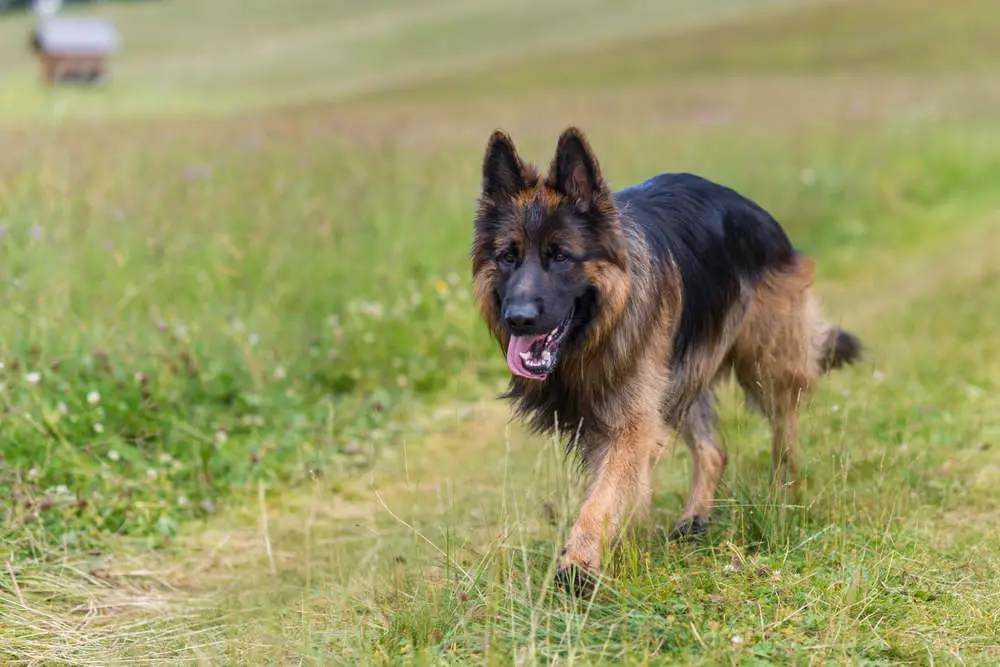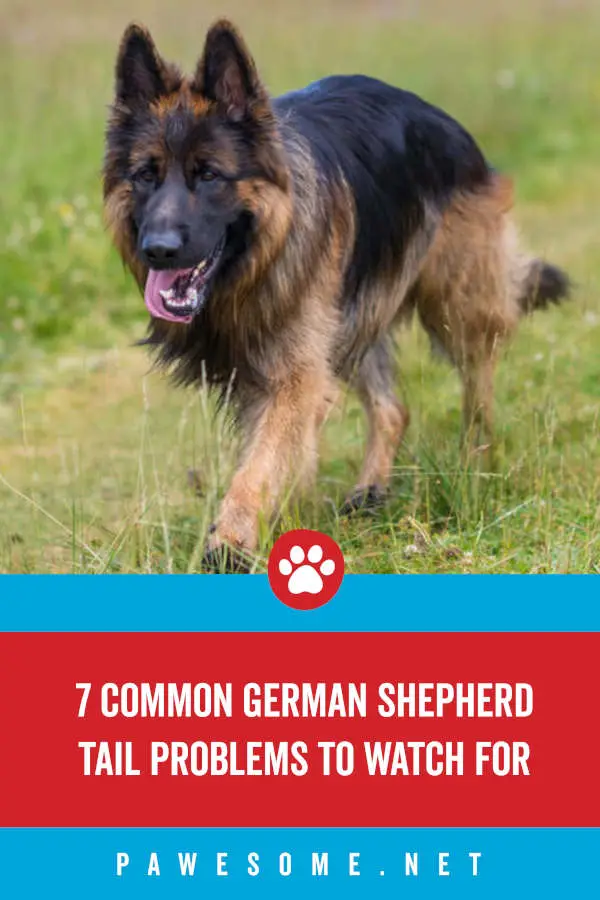
German Shepherds are lovely dogs that make for great pets and excellent watchdogs. Their tail is something a lot of dog parents worry about.
So, we are here to clear the air on some myths and alert you to the possible problems you may encounter. We’ll also tell you what you can do. Let’s start.
Too Much Wagging
It is not uncommon for German Shepherds to wag their tails a lot. Unfortunately for them and for us, this can lead to injuries. They do this a lot because they are very enthusiastic dogs and in the process of wagging their tails, they knock them into the things around them and get hurt.
It could lead to a pulled muscle, a cut or a bruise. But sometimes, this excessive wagging of the tail might be because of anxiety or stress. So, it’s good to check on them when it’s happening an awful lot.
While we’re talking about tail wagging, let’s also touch upon the issue of docking the tail. It is sometimes done to make sure that the dog doesn’t get hurt since it is so prone to wagging its tail so much.
It is a controversial practice for a reason and you won’t really be protecting the German Shepherd all that much. Sometimes, people consider it to be an acceptable procedure for working dogs but it is important to understand that docking the dog’s tail isn’t a need.
Aussies and corgis often undergo this procedure because they work with big farm animals like oxen and cows. It is believed to protect their tails.
But in the case of a German Shepherd, this argument is not even applicable because when they do, these dogs work with smaller animals like geese, goats, ducks and sheep. This leaves very little scope for working German Shepherds to injure their tails while engaging with other animals.
Also Read: 36 Adorable German Shepherd Mixes With Pictures
Curled tail
A curled tail is not unusual in German Shepherds. It is often a genetic fault and there is nothing to be done about it.
What might help is knowing that your dog is not experiencing discomfort or pain because of this. But sometimes, dog parents decide to go for surgery so that the tail looks straight which is associated with strength and power.
Unfortunately, the surgery doesn’t really solve any problem and is an expensive procedure too. If you have a German Shepherd, remember that your dog isn’t looking like a wimp as you might perceive it. So, just leave the tail alone.
The surgery also doesn’t mean that your dog’s puppies won’t have a curled tail. In fact, they will have it.
A curled tail among German Shepherds is also called a gay tail sometimes because it tends to wag its tail a lot, usually out of joy and gay is just another word for it. All you need to know is that it does not impact your dog’s health and that’s the most important thing.
Chasing Tail
Then there is the curious phenomenon of German Shepherds chasing their own tails. It’s a characteristic that fits the description of a lot of dog breeds and it’s occasionally true for German Shepherds too.
And when they do catch the tail they growl slowly. It’s nothing to worry about because that is a growl of victory if there is such a thing.
Watching this can be amusing because it tells you about the dog’s state of mind. And it isn’t particularly a problem unless they start doing it obsessively.
There are lots of reasons why your German Shepherd might be chasing its own tail. Most of the reasons are related to their behavior which means you can fix it by training them properly.
Typically, they do it when they are anxious, stressed, don’t have enough space or aren’t getting enough exercise. In fact, they do this when they are in a small space because it makes them anxious. So, those two problems are connected and you can get rid of one by solving the other.
The dogs also chase their tail when they are really bored. This happens if they have been home bound for a couple of days and are not getting enough exercise.
It chases its own tail as a way to exercise itself because that’s all it can think of. It’s the German Shepherd’s version of stretching its legs.
The problem occurs when they do it a lot, forgetting their surroundings. That’s because they might end up hurting themselves.
Also Read: 5 Different Types of German Shepherds
Limber Tail Syndrome
If you were looking for medical conditions related to the tail, here’s one you should know. The limber tail syndrome is also called the broken or cold tail syndrome.
It is a condition that occurs when the dog has damaged the muscles in its tail by being in cold water for too long. You know this is the case when you see symptoms like:
- A painful tail
- Cramps
- A swollen tail
Typically, the tail will heal itself with enough time away from the water but if your German Shepherd is in a lot of pain, you can get some pain killers from your vet.
Skin Infection
Skin infection on the tail is also not uncommon among German Shepherds. This often leads to hair loss and the dog scratching itself because of itchiness.
You might also see your German Shepherd chew on its tail to deal with the itching. But that’s not a good thing because it might lead to scraps that will make the infection worse.
The same is true for licking the tail when there is a cut because it worsens the cuts by making it bigger and you don’t want that. You should do the first thing you think you should do in these situations which is to see a vet.
They are likely to give the dog an antibiotic which will solve the problem the way it should.
Anal Furunculosis
This is a hereditary problem that is the result of chronic skin inflammation. It usually starts to appear below the tail and surrounds the anus, hence the name.
But the actual problem is in the immune system which doesn’t work the way it is supposed to. You can avoid this problem by making sure that the parents of your German Shepherd do not have anal furunculosis.
Biting the Tail
Then there is the constant biting of the tail. There are several reasons for this behavior and it can happen at any point in time.
Playing with the tail is usually the reason your German Shepherd is biting its tail. It is kind of in the family of chasing its own tail. You can tell if they are being playful or it’s a problem by observing your dog and figuring out its mood.
Fleas and allergies are also possible reasons for this behavior. In that case, you must talk to your vet.
Other Little Details
- Sometimes, German Shepherds place their tails downwards between their legs which means they are upset, unwell or sad. And this is how they are communicating it.
- If you notice that your German Shepherd is hanging their tail between the back legs, it means your dog is relaxing or saving energy.
- If the dog is wagging their tail slowly, it means that they are confused about something. This is likely to happen when they are in a new place.
German Shepherds observe their surroundings carefully and they do this in the process of understanding the atmosphere.
- When a German Shepherd is scared or does not want to be hurt, it hides the tail between the hind legs. This is definitely the case if their ears are also pinned back.
- And if the tail is straightened out, your German Shepherd is preparing to start a fight with another dog. Moving the tail to its back is its way of showing aggression.
- If you see that a German Shepherd’s tail is a little stiff and high, the dog is trying to show someone who’s the boss. The tail can also be curled and it means the same.
The way you know, it’s a show of strength is that this tail posture is usually accompanied by lots of barking. But if they’re barking for no apparent reason, they are just trying to get your attention.
What Can You Do?
It’s important for every dog parent to keep an eye on their dog’s behavior. If you notice hair fall or cuts on the tail, make sure you call the vet right away.
The same is true for a lot of scratching or biting the tail or anal region. It could be a skin infection and this scratching and biting makes it worse.
Make sure you groom the dog regularly and check its body when you do. This means looking under the tail, checking their toes and tail.
It’s also a good time to check the state of their coat so that there are no fleas.
Also Read: When Do German Shepherds Stop Teething?
In Conclusion
German Shepherds are likely to live for about 10 to 13 years and it’s not difficult to make sure that it’s not the tail that is reducing their lifespan.
Wagging its tail too much, chasing the tail for no apparent reason, scratching and biting it are all problem areas. But they can be solved easily too.
Then there are health conditions. While some are hereditary, others just need to be avoided to make sure the pup is happy and healthy.

